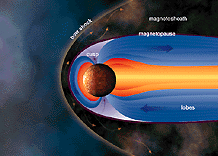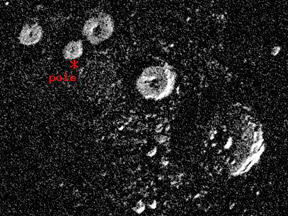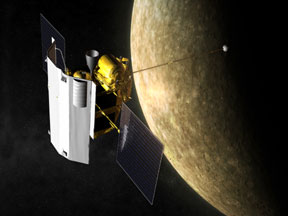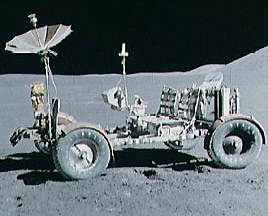This is what MESSENGER might look like when it gets to Mercury. The white sunshade is on the left side of the spacecraft.
Image courtesy NASA/Johns Hopkins University Applied Physics Laboratory/Carnegie Institution of Washington.
MESSENGER Mission to Mercury
A new spacecraft is going to the planet Mercury. The spacecraft is called
MESSENGER. MESSENGER is only the second spacecraft ever to visit Mercury!
MESSENGER will blast off in August 2004. It will get to Mercury seven years
later in 2011. It will take a crazy path on its way to Mercury. It will fly
by Earth once, Venus twice, and Mercury three times! Then it will go into orbit
around Mercury.
Mariner
10 is the only other spacecraft to visit Mercury. It took pictures
of about half of Mercury in the mid 1970's. MESSENGER will take pictures of
all of Mercury. It will also study the surface, inside, and magnetic
field of Mercury.
Mercury is very hot because it is so close to the Sun.
Why won't MESSENGER get fried? The spacecraft has a special sunshade to keep
it cool. The sunshade is like the umbrellas people take to the beach for shade!
You might also be interested in:

Mercury is the only inner planet other than the Earth that has a significant magnetic field (220 nT). This field, along with the planet's high density and small size relative to the Earth, indicates that
...more
Most planets are tilted. Their North and South Poles are not straight up and down. Earth is tilted a medium amount. Uranus is tilted a lot. Mercury is hardly tilted at all. It is tilted less than any other
...more
A new spacecraft is going to the planet Mercury. The spacecraft is called MESSENGER. MESSENGER is only the second spacecraft ever to visit Mercury! MESSENGER will blast off in August 2004. It will get
...more
The Hubble Space Telescope (HST) is really neat! It was first launched in 1990, but scientists started building it in the 1970's! We have found all kinds of objects like stars, nebulae and galaxies. The
...more
Apollo 11 was the first mission that landed a person on the moon. On July 16, 1969, the U. S. rocket Saturn 5 was launched carrying the lunar landing module Eagle. The Eagle was released and it reached
...more
Apollo 12 was launched on Nov. 14, 1969 and arrived at the Moon three days later. Astronauts Charles Conrad and Alan Bean descended to its surface, while Richard Gordon remained in lunar orbit aboard the
...more
Apollo 15 marked the start of a new series of missions from the Apollo space program, each capable of exploring more lunar terrain than ever before. Launched on July 26, 1971, Apollo 15 reached the Moon
...more














